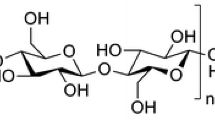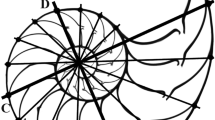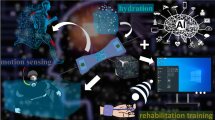Summary
The present investigation is concerned with the topography and ultrastructure of sensory nerve endings in the joint capsules of the Kowari (Dasyuroides byrnei), an Australian marsupial. Material for light and electron microscopy was obtained from shoulder, elbow and knee joint capsules.
On the basis of differences in the organization of the connective tissue belonging to the fibrous layer, 3 variants of capsule structure have been distinguished: a rigid, a flaccid and an intermediate type. Whilst the rigid type is characterized by dense connective tissue in the clearly demarcated fibrous layer, the flaccid type shows loose, irregularly arranged connective tissue in the fibrous layer which merges into the synovial layer of the joint capsule. the morphology of the intermediate type corresponds to an intermediate stage between the former two types.
In the fibrous layer of the joint capsules three different types of sensory nerve endings were observed: free nerve endings, Ruffini corpuscles and lamellated corpuscles. The free nerve endings are supplied by myelinated afferent axons (1–2 μm in diameter); the terminal thickenings of which are incompletely surrounded by a terminal Schwann cell. Ruffini corpuscles are present in three different varieties: 1. small corpuscles without a perineural capsule predominantly within the flaccid part of the capsule; 2. slightly larger corpuscles with an incomplete perineural capsule and 3. large corpuscles resembling Golgi tendon organs which predominantly occur in the rigid parts of the capsule. The afferent myelinated axons measure 2–4 μm in diameter. The lamellated corpuscles show two variants: 1. small corpuscles with a 2 to 4-layered perineural capsule in the rigid parts of the joint capsules and 2. large corpuscles with two longitudinal clefts of the inner core in the flaccid parts. Both types are supplied by myelinated axons of 3–5 μm in diameter. Thus, in the fibrous layer of the rigid type of joint capsules large Ruffini and small lamellated corpuscles predominate, whereas the fibrous layer of the flaccid type coincides with small Ruffini and large lamellated corpuscles. The present data, therefore, corroborate the concept that the morphology of mechanoreceptors depends upon the texture of the surrounding connective tissue.
Similar content being viewed by others
References
Andres KH, von Duering M (1973) Morphology of cutaneous receptors. In: Autrum H, Jung R, Loewenstein WR, MacKay DM (eds) Handbook of sensory physiology. Springer, Berlin New York, pp 3–28
Barland P, Novikoff AB, Hamerman D (1962) Electron microscopy of the human synovial membrane. J Cell Biol 14:207–220
Barnes RD (1968) Small marsupials as experimental animals. Lab Anim Care 18:251–257
Bloom W, Fawcett DW (1986) A textbook of histology. Saunders Philadelphia
Chambers MR, Andres KH, von Duering M, Iggo A (1972) The structure and function of the slowly adapting type II mechano-receptor in hairy skin. Q J Exp Physiol 57:417–445
Freeman MAR, Wyke B (1967) The innervation of the knee joint. An anatomical and histological study in the cat. J Anat 101:505–532
Gardner ED (1942) Nerve terminals associated with the knee joint of the mouse. Anat Rec 83:401–420
Grigg P, Hoffman AH (1984) Ruffini mechanoreceptors in isolated joint capsule: response correlated with strain energy density. Somatosens Res 2:149–162
Grigg P, Hoffman AH, Fogarty KE (1982) Properties of Golgi-Mazzoni afferents in cat knee joint capsule, as revealed by mechanical studies of isolated joint capsule. J Neurophysiol 47:31–40
Groth H-P (1975) Cellular contacts in the synovial membrane of the cat and rabbit: an ultrastructural study. Cell Tissue Res 164:525–541
Halata Z (1975) The mechanoreceptors of the mammalian skin. Ultrastructure and morphological classification. Adv Anat Embryol Cell Biol 50:1–77
Halata Z (1977) The ultrastructure of the sensory nerve endings in the articular capsule of the knee joint of the domestic cat (Ruffini corpuscles and Pacinian corpuscles). J Anat 124:717–729
Halata Z, Badalamente MA, Dee R, Propper M (1984) Ultrastructure of sensory nerve endings in monkey (Macaca fascicularis) knee joint capsule. J Orthop Res 2:169–176
Halata Z, Djajasaputra T (1985) Die Ultrastruktur der Vater-Pacinischen und Ruffinischen Körperchen in der Kniegelenkkapsel des Menschen. Verh Anat Ges 79:505–506
Halata Z, Groth H-P (1976) Innervation of the synovial membrane of cat knee joint capsule. Cell Tissue Res 169:415–418
Halata Z, Munger BL (1980) The ultrastructure of the Ruffini and Herbst corpuscles in the articular capsule of domestic pigeon Anat Rec 198:681–692
Halata Z, Munger BL (1983) The sensory innervation of the primate facial skin. II. Vermilion border. Brain Res Rev 5:81–107
Halata Z, Rettig T, Schulze W (1985) The ultrastructure of sensory nerve endings in the human knee joint capsule. Anat Embryol 172:265–275
Ide C, Kamagai K, Hayashi S (1985) Freeze-fracture study of the mechanoreceptive digital corpuscles of mice. J Neurocytol 14:1037–1052
Ito S, Winchester RJ (1963) The fine structure of the gastric mucosa in the bat. J Cell Biol 16:541–578
Kölliker A (1889) Handbuch der Gewebelehre des Menschen. Engelman Leipzig, pp 312–314
Krause W (1881) Die Nervenendigung innerhalb der terminalen Körperchen. Arch Mikrobiol Anat 19:53–136
Kruger L, Perl ER, Sedivec MJ (1981) Fine structure of myelinated mechanical nociceptor endings in cat hairy skin. J Comp Neurol 198:137–154
Laczko J, Levai G (1975) A simple differential staining method for semi-thin sections of ossyfying cartilage and bone tissue embedded in epoxy resin. Mikroskopie 31:1–4
Luft JH (1961) Improvements in epoxy resin embedding methods. J Biophys Biochem Cytol 9:409–414
Malinovsky L, Novotny V (1980) Ultrastructure of sensory corpuscles in joint capsules of the bat (Myotis myotis). Folia Morphol (Praha) 28:230–232
McCloskey DI (1978) Kinesthetic sensibility. Physiol Rev 58:763–820
Nicoladoni C (1873) Über die Nerven der Kniegelenkskapsel des Kaninchens. Med Jb (Wien): 401
Pac L (1975) Ultrastructure of the joint receptors of the tortoise (Testudo graeca, Emys orbicularis). Z mikrosk-anat Forsch 89:1068–1078
Pac L (1978) Ultrastructure of the joint receptors in the frog (Rana temporaria). Z mikrosk-anat Forsch 92:744–752
Pease DC, Quilliam TR (1957) Electron microscopy of the Pacinian corpuscle. J Biophys Biochem Cytol 3:331–342
Polacek P (1961) Differences in the structure and variability of encapsulated nerve endings in the joint of some species of some mammals. Acta Anat (Basel) 47:112–124
Polacek P (1965) Differences in the structure and variability of spray-like nerve endings in the joint of some mammals. Acta Anat (Basel) 62:568–583
Polacek P (1966) Receptors of the joints. Their structure, variability and classification. Acta Fac Med Univ Brunensis 23:1–107
Rauber A (1874) Über die Vater'schen Körper der Gelenkkapseln. Cbl Med Wiss (Wien) 12:305–306
Reynolds ES (1963) The use of lead citrate at high pH as an electron opaque stain in electron microscopy. J Cell Biol 17:208–212
Rüdinger N (1857) Die Gelenknerven des menschlichen Körpers. Enke, Erlangen
Schoultz TW, Swett JE (1972) The fine structure of the Golgi tendon organ. J Neurocytol 1:1–26
Schoultz TW, Swett JE (1976) Ultrastructural organisation of the sensory fibres innervating the Golgi tendon organ. Anat Rec 179:147–162
Spray DC (1986) Cutaneous temperature receptors. Ann Rev Physiol 48:625–638
Tracey D (1978) Joint receptors—changing ideas. Trends Neurosci 1:63–65
Author information
Authors and Affiliations
Additional information
Supported by the Verein zur Förderung der Erforschung und Bekämpfung rheumatischer Krankheiten e.V. in Bad Bramstedt, and by the Deutsche Forschungsgemeinschaft (Ha 1194/2-1)
Rights and permissions
About this article
Cite this article
Strasmann, T., Halata, Z. & Loo, S.K. Topography and ultrastructure of sensory nerve endings in the joint capsules of the Kowari (Dasyuroides byrnei), an Australian marsupial. Anat Embryol 176, 1–12 (1987). https://doi.org/10.1007/BF00309746
Accepted:
Issue Date:
DOI: https://doi.org/10.1007/BF00309746




